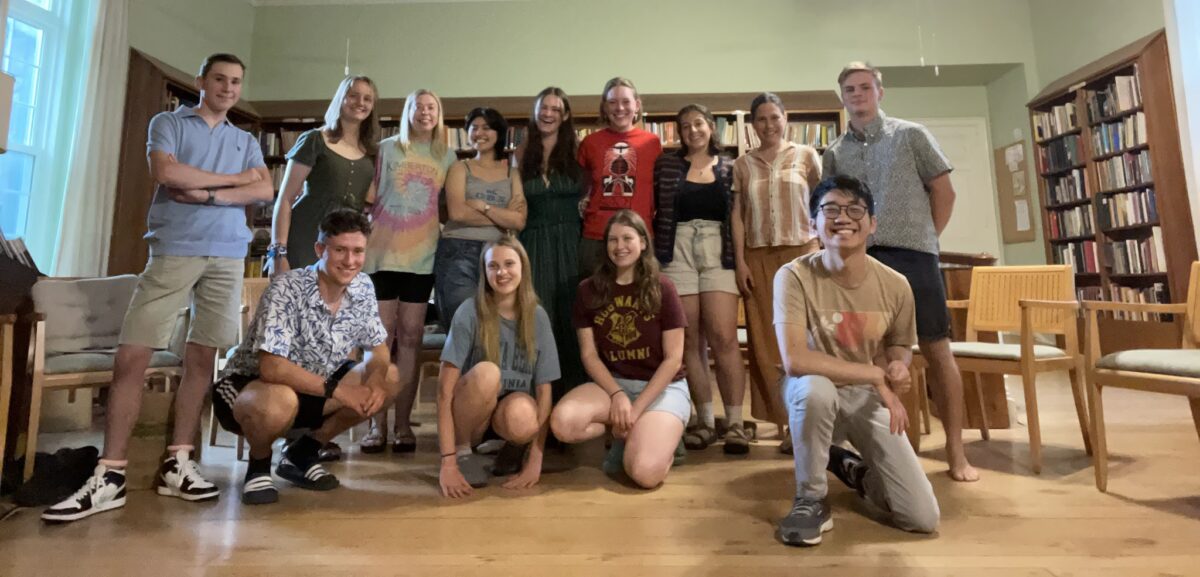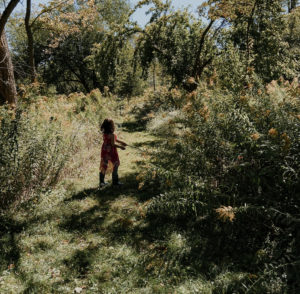
“A child is innately wise and realistic.” – A.S. Neill, Summerhill
On my first day at the Antioch School, I was told that the work that I would be doing at the school would be based mostly on observation. I was reassured not to be discouraged by this, for learning happens within discovery. I watch students all day long, from 10:00 am to 3:30 pm most days and as I wander around the school I watch them ride around their bicycle path with Ripstiks and unicycles, falling down only to get right back up and try again. At this school, children are encouraged to take the next step, to take risks, and to make mistakes. The Antioch School is a place where childhood is respected and children are enjoyed.
In 1921, the Antioch School was founded by Arthur Morgan as one of the country’s first alternative schools. The Antioch School prides itself on being a democratic educational institution, meaning both the students and the teachers collaborate together to create the curriculum and classroom rules they wish to follow for the academic year. Unlike other schools, the Antioch School allows students to take full advantage and ownership of their own learning. Arthur Morgan, the founder of the Antioch School emphasized that education should teach children about the joy of living, “Youth is naturally exuberant. School experiences… in discovering the tempting secrets of science and in listening to the appeal of good literature, history, music, and art, should help young people to acquire an appreciation of life which will carry over into their adult years the youthful joy of living.”
This democratic educational paradigm is replicated through the classroom dynamic in everyday experiences. There is no hierarchy within the classrooms, as the teachers all collaborate together with the school manager to make the school function as a whole. The different groups of students (Nursery, Kindergarten, Younger Group, and Older Group) interact with each other on a daily basis although each classroom has its own curriculum and class guidelines to follow. For the most part during my co-op, I have been working with OG and Kindergarten which has been incredibly rewarding to work with two drastically different age groups. Almost once a month, OG and YG students get together with the teachers for an “All-School Meeting” run by OG students. This meeting is where the students in both classrooms are given the space to talk about indifferences they have been facing or issues they have with the school. In our meeting this month, the students discussed solutions for the dirty bathrooms and hallways. I told them to not be embarrassed, that even at my school at Antioch College the adults I live with have trouble flushing the toilets and picking up their toilet paper. They laughed. I said I am not kidding.
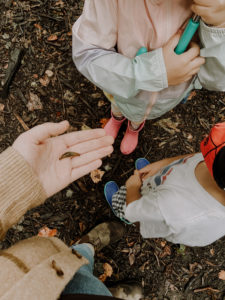
Slug friend!
When I visited the Antioch School for my job interview in the spring, one of the first things I noticed when I walked into the building were the unicycles lined up along the long windowed hallway. When I asked Nathan Summers, the current school manager, about the unicycles he told me that unicycles became a school symbol for the Antioch School beginning in 1969. Unicycles offer a “uni-que” challenge for students, an activity that requires consistent perseverance and patience. Something that might knock them down, but will also teach them the importance of tenacity and persistence.
At the Antioch School, the children are encouraged to pursue their natural curiosity. The teachers at this school all hold the same value that the primary role of an educator is to find and nurture individual student’s innate sense of direction and curiosity. As Ann Guthrie, the teacher of the Nursery group of children writes in Don Wallis’ book, Children of a Child-Centered School, “Teaching is a subtle art… I believe that good teaching comes out of good observing, knowledge of child development, intuition, an ability to read the individual, and a good sense of timing. A good teacher knows when to step in and when not to step in. I believe that teaching is much more art than science. I believe that teaching is also learning.”
Just like Antioch College, the Antioch School is a small school with a central belief that a safe, trusting, and loving community is central to learning. Each year the enrollment for the school averages out to approximately sixty students, ages three years old to twelve. The Antioch School is a small school tucked away in between the Antioch College campus and a nature preserve, the Glen Helen. At this time of the year, native Ohio wildflowers encompass the childrens’ surroundings. Goldenrod and purple aster flowers sprout around the school, a building with a hallway of glass windows that allows natural light to flood the classrooms filled with houseplants, books, and crafting supplies.
They have a garden where they planted tomatoes, pumpkins, cucumbers, and peppers to enjoy for afternoon snacks. Just beyond the garden is a chicken coop where three chickens (Sleepy, Jaz, and Easter) are chased around all day. On the playground, they have a merry-go-round, a tire swing, a giant sandpit, monkey bars, and swings. At the Antioch School, play is prioritized so we spend most of our time outside exploring. On Mondays, we take hikes in the Glen and every month the Kindergartners go to Agraria where they explore the limestone-ridden creek, the “maze” of goldenrod, and the forest of trees.
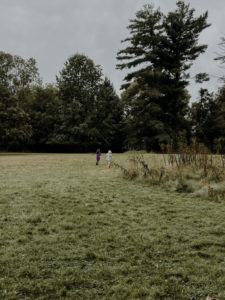
Outside of the forest classroom.
Since beginning my co-op position at the beginning of September, I have learned that exploration, curiosity, and play are key elements to learning. Children are brave and strong when you give them the space to be children, and at the Antioch School, the students have so many resources to use their imagination. I have co-opped in three different educational institutions. My first co-op was at Paraclete, an after-school program in South Boston. I then co-oped at Buen Día Family School, a bilingual arts-based school in San Francisco. My most recent co-op was at the Yellow Springs High School here in the village during the pandemic. However, I have never worked at a place like the Antioch School. Whenever I talk to parents when they pick up their children at the end of the day, I always hear the same things, “I wish I could have gone here as a kid,” or “Man, if only every kid could go to a school like this,” and I share theses exact same sentiments. It is imperative that we let children be children. It is important that we let our children explore and create without fear of messing up. Through play and curiosity, the children at the Antioch School learn important things such as the value of choice and consequences. The children here at the Antioch School are supplied with the resources to collaborate with other students, work together to problem-solve, and explore the natural world. Being at the Antioch School, I have seen what a healthy trusting educational experience can look like. Through self-discovery and looking at the whole child rather than just an academic side of a student, the children at the Antioch School spend every day loving their school and their community, something a lot of us weren’t lucky enough to experience as a child. The amount of agency the students have at the Antioch School is truly freeing in a way that I didn’t know education could be and the daily activities I have been doing with the students like hunting for fairies, making potions, or even just playing Capture the Flag have been healing. The students and teachers at the Antioch School are teaching me to slow down and to see the fairy ponds; to see the wonder, magic, and beauty of each day.
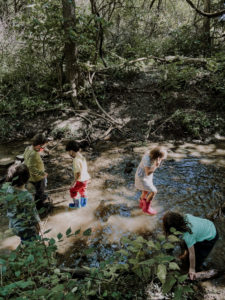
Wading in the Jacoby creek.
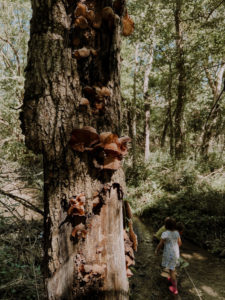
Magical mushrooms found on a tree by Jacoby creek
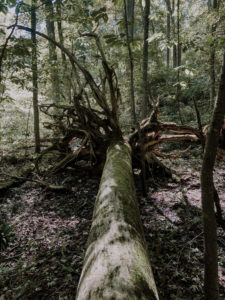
A tree found on our Glen hike.
“As important to the children as the development of academic skills is their emotional, social, and physical growth. Children are encouraged to realize their capabilities in the whole spectrum of living. Love, respect, encouragement, letting the children be– these are the most important parts of the curriculum. The children learn self-discipline, they learn to use self-initiative, they learn to make choices. They learn to help others. They learn to try, not to be afraid to do. And mostly, they experience the joy of being children.” Antioch School Parent-Teacher Curriculum Committee, 1979
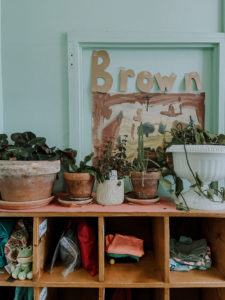
Inside of the school details.
Quotes are taken from Wallis, Don. Children of a Child-Centered School. OYO Press, 2005.
A day in the life at the Antioch School:
10:00 am – Arrival. I start my day off with the Older Group. Usually, when I arrive at 10:00, students are scattered throughout the playground. Some students ride tricycles and unicycles around the playground while others swing on the swings, play on the monkey bars and merry-go-round, and some students play group games like Capture the Flag or Circle Freeze Tag.
11:00 am – Time for “Independent Work.” I help students with their independent work packets. I help OG students review their spelling words for their spelling tests. I also help them with long division and multiplication, even though I had to get a refresher on this lesson as well!
11:30 am – Lunchtime. I sit with OG students outside while we stay six feet apart. We all eat our lunches together and play a riveting guessing game to figure out what everyone has for lunch. I have something that is red, it’s a fruit, and it’s not an apple. Can you guess what it is?
12:00 pm – Free time. The students are given time to explore and rest. I wander around the school attending to the different groups of children. I make sure everyone is accounted for and safe. This time I also use to water plants around the building sometimes.
12:30 pm – Read Aloud Time. This is my favorite part of my day. Sally (the OG teacher) and I corral all the students to the back of the school. This is where we have read-aloud time where Sally reads from a book and the students listen, draw, and sit quietly while she reads. We have been reading Wonder by R.J. Palacio which is an incredibly engaging book, especially the way that Sally reads it.
1:00 pm – History Lesson or Group Game. This time of the day students are given a history lesson or time to play a group game together. Some group games we came up with for this year are: Color Freeze Tag, Capture the Flag, Charades, Twenty Questions, Pictionary, and Hangman.
1:45 pm – Forest Kindergarten Classroom. At this time I walk to the Kindergarten forest classroom. I find the Kindergarteners usually playing in the leaves and chasing chipmunks or fairies around. At this time, I help the Kindergarten teacher Linde with corraling the Kindergarteners to pack their stuff up and do their end of the day jobs. I usually help the students pick up sand toys and at the very end of our day, I help the Kindergarteners pack their backpacks up with their creations from the day along with their lunch pails, fun treasures (sticks, yarn, rocks, acorns), and jackets.
3:00 pm – Going back home. At around 3:15 or 3:30 every day, I leave the Antioch School and prepare for the next day of adventure.
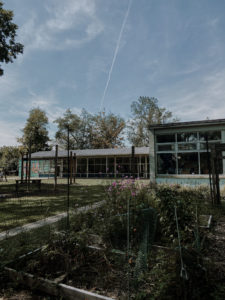
The outside of the school from the garden area.
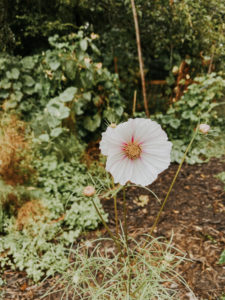
Garden find.

The garden.





